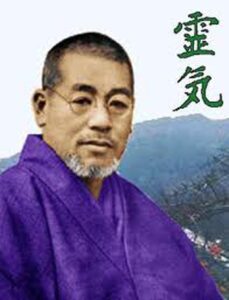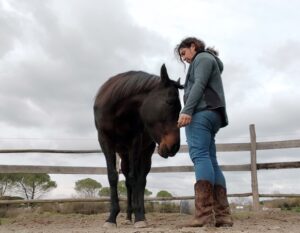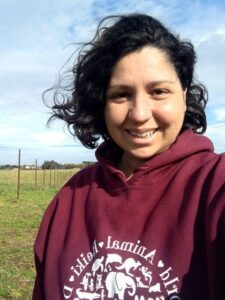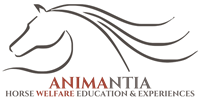Reiki, a valuable support for the health of horses (and not only)
by Elisa Munafò
Every animal, wild or domestic, is naturally predisposed to be in the flow of events that happen “here and now”, both within oneself and in the surrounding environment. This expertise is also valid for human being puppies, before layers and layers of rational thinking take them away from their natural mammalian instincts. Nevertheless it is possible, as well as desirable, to cultivate this awareness. How?
 A precious teaching has been handed down to us by master Mikao Usui, who lived in Japan between the end of the 19th century and the first decades of the 20th century. In his path of research and spiritual growth, Usui understood that there is a single energy that unites every living being. He experienced on himself that having access to this inexhaustible source of universal energy brought well-being and healing. He decided then to define and pass on the principles of a natural healing system that he named ‘Reiki’, which literally means “Universal Life Energy”, with the hope that more and more people could benefit from it. A network of masters and their descendants have spread its teachings up to the present day and, although different schools have branched out over time with more or less marked differences, the root of Reiki remains common.
A precious teaching has been handed down to us by master Mikao Usui, who lived in Japan between the end of the 19th century and the first decades of the 20th century. In his path of research and spiritual growth, Usui understood that there is a single energy that unites every living being. He experienced on himself that having access to this inexhaustible source of universal energy brought well-being and healing. He decided then to define and pass on the principles of a natural healing system that he named ‘Reiki’, which literally means “Universal Life Energy”, with the hope that more and more people could benefit from it. A network of masters and their descendants have spread its teachings up to the present day and, although different schools have branched out over time with more or less marked differences, the root of Reiki remains common.
To get an idea, we can define the discipline of Reiki as a form of meditation that is learned from a master (or teacher) and first practiced on oneself, for one’s own physical, mental, emotional and spiritual balance, and then in favor of other living beings open to receiving it.
In a typical Reiki session for people, the practitioner gently places (or only approaches) his hands on various parts of the body of the person receiving the treatment, like a massage in which, however, one remains dressed and the operator’s hands remain stationary longer in a spot before moving. This work not only brings well-being but is also particularly precious when we relate to someone who needs help, including animals. To accompany animals along the path of psychophysical balance it is important to have explored that path firsthand.
When I offer Reiki to domestic or wild animals, I take into account their high sensitivity and I place myself in a peaceful attitude, aware of my state of mind and without masks; in this way I bring an invisible space of peace in which to feel safe and free to choose whether and how to participate in the experience.
Horses often intuitively accept the invitation to enter this “energy bubble” without requests or expectations, and demonstrate their appreciation mostly with signs of relaxation; for example, they lower their head, squint, chew, lick their lips, yawn, sigh, and so on. It happened that some lay down next to me, others literally leaned on me, still others indicated with their snouts an area of their body where they were in pain or positioned themselves near my hands to ask for physical contact at that point. Once, in a pasture, one of them after a while went away. He went to the herd mates who were standing on the sidelines and encouraged them to move towards me (basically he left a good review…). Others, on the other hand, choose to remain distant, but are no less connected for this. Among the horses with whom I have shared the experience of Reiki up to now, I note that, having overcome any initial distrust, those with stories of psychophysical trauma abandon themselves more to the pleasure of a session, as if they were finding a refuge in which to give relief to their wounds.

The benefits of Reiki for horses, as well as for other animals, are numerous: as a complementary holistic remedy it is free of contraindications, non-invasive and useful for supporting every therapeutic and recovery path. In short, it is a partner who collaborates without antagonisms with other disciplines and professionals, medical and otherwise, rowing in favor of the well-being of the individual. Reiki contributes to health maintanance and can speed up the healing process from injuries and pathologies, support convalescence after surgery and invasive therapies, give relief from both acute and chronic pain and help important events such as pregnancy, birth, transfers or loss of a partner. When the time comes, Reiki can also smooth the natural transition from life to death. Since it supports the body’s energy rebalance, it also works on an emotional and, consequently, behavioral level.
But beyond words and theories, Reiki is a practice, an experience to be lived firsthand, for oneself and for one’s animals. Giving yourself the benefit of trying it, with a practitioner who inspires confidence, is the best way to find out if the path that Master Mikao Usui illuminated over a century ago is for you and your animals, too.
 Elisa Munafò (Valenza, 1981) started practicing Reiki in 2012, as part of a personal growth journey that also includes Vipassana meditation, yoga and Bach flower therapy. In 2016 she received the second level of Reiki Usui Shiki Ryoho from teacher Lida Perry (The Reiki Alliance) and subsequently, driven by her love for animals, she deepened the peculiarities of Animal Reiki by meeting with Natasha Albeer (Natural With Horses, UK) and with Kathleen Prasad (Animal Reiki Source, USA), founder of the Let Animals Lead® method. She is part of SARA Shelters Animal Reiki Association, whose volunteers offer Reiki as a complementary support to the care of animals in need by collaborating with veterinarians and rescue centres. She currently lives in Rome.
Elisa Munafò (Valenza, 1981) started practicing Reiki in 2012, as part of a personal growth journey that also includes Vipassana meditation, yoga and Bach flower therapy. In 2016 she received the second level of Reiki Usui Shiki Ryoho from teacher Lida Perry (The Reiki Alliance) and subsequently, driven by her love for animals, she deepened the peculiarities of Animal Reiki by meeting with Natasha Albeer (Natural With Horses, UK) and with Kathleen Prasad (Animal Reiki Source, USA), founder of the Let Animals Lead® method. She is part of SARA Shelters Animal Reiki Association, whose volunteers offer Reiki as a complementary support to the care of animals in need by collaborating with veterinarians and rescue centres. She currently lives in Rome.
Contact: reiki@animantia.it – FB: Reiki per gli animali

